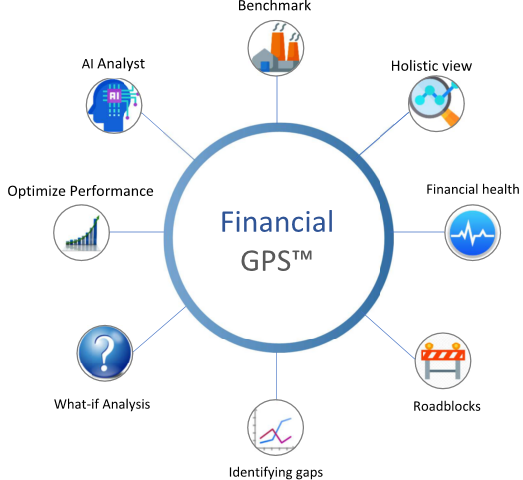Unlock new insights alongside your existing tools
What is Financial GPS?
Financial GPS℠ is a strategic platform that guides CFOs toward peak financial performance and growth, much like a car GPS directs drivers. Going beyond traditional analytics, it combines industry benchmarking, predictive insights, and data-driven recommendations to reveal performance gaps and opportunities that internal data alone may miss. Acting as a proactive partner, Financial GPS helps CFOs navigate financial complexities, optimize resources, and make informed decisions that drive sustainable growth
Benchmark 800 Industries
Benchmarking against 800 industries provides CFOs with a clear view of their company’s standing within the market, revealing whether they lead, follow, or diverge from industry trends. This insight enables strategic alignment with best practices, identifies value-driving initiatives, and supports informed, competitive decision-making that fosters innovation and boosts performance.
Holistic View
Achieving a comprehensive view of your company’s performance means analyzing key dimensions like liquidity, profitability, asset efficiency, leverage, and sustainable growth. This multi-dimensional approach provides a deeper perspective on strengths, weaknesses, and opportunities, empowering you to make informed decisions and implement strategies that drive success
Financial Health
The Financial Health Monitor is a powerful tool that gives you a 360-degree view of your company’s financial well-being. It offers real-time insights and alerts, helping you spot and resolve potential issues before they turn into major problems. By understanding the scale and scope of these issues, you can take proactive steps to avoid financial crises. With the Financial Health Monitor, you’ll be better equipped to manage your company’s financial stability, ensuring long-term success and sustainability.
Identify Roadblocks
Operational financial roadblocks—such as excessive debt, poor capital allocation, or outdated systems—can hinder a CFO’s ability to drive growth. These obstacles create inefficiencies, raise costs, and reduce flexibility, making it challenging to scale operations, invest in innovation, or seize strategic opportunities like mergers or new markets. Identifying and addressing these barriers is crucial for unlocking your company’s full growth potential
Identify and Close Gaps
Closing performance gaps starts with benchmarking against industry standards to establish a clear baseline. By pinpointing and assessing these gaps, along with their financial impact, CFOs can explore data-driven options to address them effectively. This approach reduces the time needed to bridge gaps, optimizes financial outcomes, and supports continuous improvement for enhanced overall performance
What-if analysis
What-if analysis enables businesses to explore different scenarios, assess options, and understand their financial impact. This approach helps decision-makers evaluate both short- and long-term outcomes, prioritize resources effectively, and uncover opportunities for operational efficiency. By examining multiple possibilities and their combined effects, organizations can make strategic decisions, mitigate risks, and drive improved performance
Optimize Performance
Financial roadblocks constrain a CFO’s ability to boost company performance and growth by causing inefficiencies, increasing costs, and reducing adaptability. Challenges like high debt, poor capital allocation, and outdated systems limit quick decision-making, make scaling difficult, and restrict innovation investment. These barriers ultimately prevent the CFO from pursuing strategic opportunities, such as mergers or market expansion, which are crucial for long-term growth.
Embracing AI
AI-powered financial insights deliver deeper understanding across the C-Suite and Boardroom by analyzing both structured and unstructured data. This technology uncovers hidden patterns and trends within vast information, enabling strategic decision-making. By integrating data from sources like financial reports, market trends, and customer feedback, AI provides executives with a holistic view of organizational performance and risks. Ultimately, embracing AI fosters collaboration, drives innovative thinking, and supports impactful decisions aligned with the company’s strategic objectives
Creating long term value
CCreating long-term value hinges on strategic decision-making and sustained impact. By asking the right questions and analyzing industry performance against benchmarks, organizations can identify strengths and improvement opportunities. A holistic view of operations reveals gaps and guides strategy development, while an understanding of market dynamics helps position the company competitively. Additionally, assessing financial resources ensures preparedness to seize opportunities and navigate changes. By integrating these insights, businesses can drive growth and achieve sustainable success in their industries









